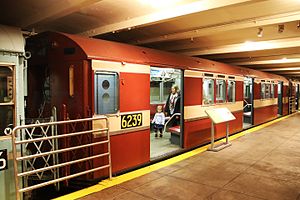| R15 | |
|---|---|
 R15 car 6239 on display at the New York Transit Museum | |
 Interior view of R15 car 6239 | |
| In service | 1950–1984 |
| Manufacturer | American Car and Foundry |
| Constructed | 1950 |
| Entered service | February 4, 1950 |
| Number built | 100 |
| Number preserved | 1 |
| Number scrapped | 99 |
| Successor | R62 |
| Formation | Single units |
| Fleet numbers | 5953–5976 and 6200–6225 (Westinghouse) 5977–5999 and 6226–6252 (General Electric) |
| Capacity | 44 (seated) |
| Operators | NYC Board of Transportation New York City Transit Authority |
| Specifications | |
| Car body construction | LAHT Carbon steel |
| Car length | 51 ft 0+1⁄2 in (15.56 m) |
| Width | 8 ft 10+3⁄16 in (2,697 mm) |
| Height | 11 ft 10 in (3,607 mm) |
| Floor height | 3 ft 9 in (1.14 m) |
| Doors | 6 sets of 50 inch wide side doors per car |
| Maximum speed | 55 mph (89 km/h) |
| Weight | 74,778 lb (33,919 kg) |
| Traction motors | Westinghouse 1447C or General Electric 1240A3 |
| Power output | 100 hp (75 kW) per traction motor |
| Transmission | Westinghouse XM-179 or General Electric 17KC76A1 |
| Auxiliaries | 100 hp (75 kW) (4 per car) |
| Electric system(s) | 600 V DC Third rail |
| Current collector(s) | Top running Contact shoe |
| Braking system(s) | WABCO Schedule SMEE with A-1 Application package, J1 relay valve, ME-42A brake stand, and A.S.F simplex unit cylinder clasp brake rigging |
| Safety system(s) | Tripcock |
| Coupling system | Westinghouse H2C |
| Track gauge | 4 ft 8+1⁄2 in (1,435 mm) standard gauge |
The R15 was a New York City Subway car model built by the American Car and Foundry Company in 1950 for the IRT A Division. A total of 100 cars were built, arranged as single units. Two versions were manufactured: Westinghouse (WH)-powered cars and General Electric (GE)-powered cars.
The first R15s entered service on February 4, 1950; the fleet initially ran on the IRT Flushing Line until the R33S and R36 World's Fair fleets were delivered in the 1960s. The R15s were replaced by the R62s in the 1980s, and the final train of R15s ran on December 10, 1984. One R15 car was saved for the New York Transit Museum, and the rest were scrapped.